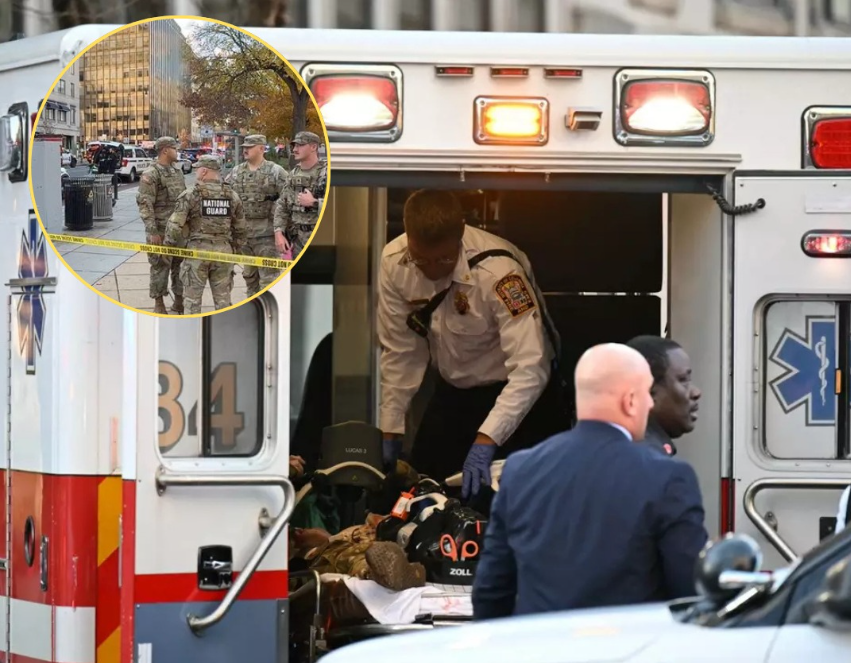Two National Guardsmen lie critically wounded, their uniforms bloodied and their faces pale with shock, just steps from the heart of American power. Sirens wail endlessly through the streets, emergency lights flicker across government buildings, and a city once humming with routine has frozen in collective terror. Barricades spring up like steel walls of protection, officers shouting orders over the din, and the nation watches helplessly as breaking news flashes across every screen. The White House, normally a symbol of calm authority, has slammed into lockdown. Armed personnel swarm the perimeter, scanning every street, alley, and doorway. Flights are halted. Public transportation slows to a crawl. For countless citizens—commuters, tourists, residents alike—time stretches thin as fear coils in every corner. And the question on everyone’s mind pulses through every headline, every social media post, every emergency broadcast: what happened at Farragut West? And what does it mean for a nation already tense, already on edge, already fragile?
The chaos began in the waning light of a Washington afternoon, a moment when city dwellers were counting the minutes until home or dinner, when tourists were lingering by monuments, oblivious to the shadow about to fall. The Metro entrance at Farragut West, ordinarily unremarkable, became the epicenter of a nightmare. Gunfire erupted suddenly, shocking, sharp, and impossible to ignore. Commuters screamed, ducked behind railings, pressed their bodies to the cold concrete, and tried desperately to make sense of what was happening. The first shots claimed two National Guardsmen, heroes who had been stationed to maintain vigilance, now fighting for their lives in a surreal blur of sirens, panic, and red-and-blue lights. A third victim, caught in the crossfire, was rushed to emergency care, their fate uncertain, the city holding its collective breath.
In moments, the security apparatus of the nation kicked into overdrive. The gates of the White House were closed, barriers raised, and armed officers positioned strategically along Pennsylvania Avenue, Lafayette Park, and every possible ingress point. Helicopters hovered above, their blades slicing through the sky with mechanical urgency. Windows across government buildings were lit with tense, watchful eyes scanning the streets below. Every staff member, every resident in the vicinity, every tourist in the area became part of a surreal tableau of fear, as if the city had paused mid-breath.
Officials scrambled to reassure a rattled public. Police statements emerged cautiously, emphasizing that the suspect had been apprehended and was under medical care. FAA directives grounded flights into Reagan National Airport, slowing the flow of a city dependent on quick transit. Meanwhile, statements from Palm Beach reverberated across national media: President Trump vowed the gunman would “pay a very steep price,” praising law enforcement, first responders, and the National Guard as “truly Great People,” a reassurance meant to remind citizens that order, at least for now, could be restored. In Washington, the National Guard released statements underscoring their commitment to protection, even as their own members lay critically injured, a poignant reminder of the delicate balance between vigilance and vulnerability in the nation’s capital.
The human stories began to emerge slowly, pieced together by witnesses and security cameras. A tourist frozen mid-step, clutching her child, recounted the sharp crack of gunfire echoing like rolling thunder through the underground tunnels of the Metro. Commuters pressed against the walls, hearts hammering, the smell of fear palpable. One officer described the surreal horror of helping wounded colleagues as chaos swirled around them: the screams, the smoke, the flashing lights, the confusion that made every decision critical and every second matter. Each story was a microcosm of the larger trauma, fragments of panic and courage interwoven.
Behind the scenes, intelligence and law enforcement agencies combed through surveillance footage, witness statements, and digital breadcrumbs, racing to understand the motive, the origin of the threat, and the chain of events that led to this attack. Meanwhile, city leaders coordinated emergency response: hospitals readied trauma units, metro stations were temporarily closed, and streets leading to the White House were reinforced with barriers and armed officers. Social media buzzed with real-time updates, photos, and videos, blending fact and fear in ways that kept every citizen on edge.
For the National Guard members now fighting for life and recovery, the episode was a stark reminder of their perilous position. Their duty had always been one of vigilance, a protective shield over the political heart of the country. Yet in a single, violent instant, that protective shield had been pierced, and the fragility of normalcy had been exposed to millions watching helplessly from afar.
By nightfall, as news anchors tried to piece together the sequence of events, the reality of the incident began to settle in. The injured were stabilized, though the road ahead remained uncertain. The city, still tense, exhaled just slightly, but the sense of vulnerability lingered. For those on duty, for those who witnessed the chaos, and for a nation glued to its screens, the lessons were clear: even the most secure city center is susceptible to sudden, unforeseen violence, and the line between routine and catastrophe is perilously thin.
As investigations continue, as the city slowly returns to motion, the tragedy at Farragut West remains a stark reminder: heroism is often quiet, sacrifice is immediate, and the work of first responders and the National Guard is ongoing, tireless, and often unseen. Life in the capital may resume, but for now, the events of that day are etched into every street, every Metro station, and every mind that watched history unfold in real time.
